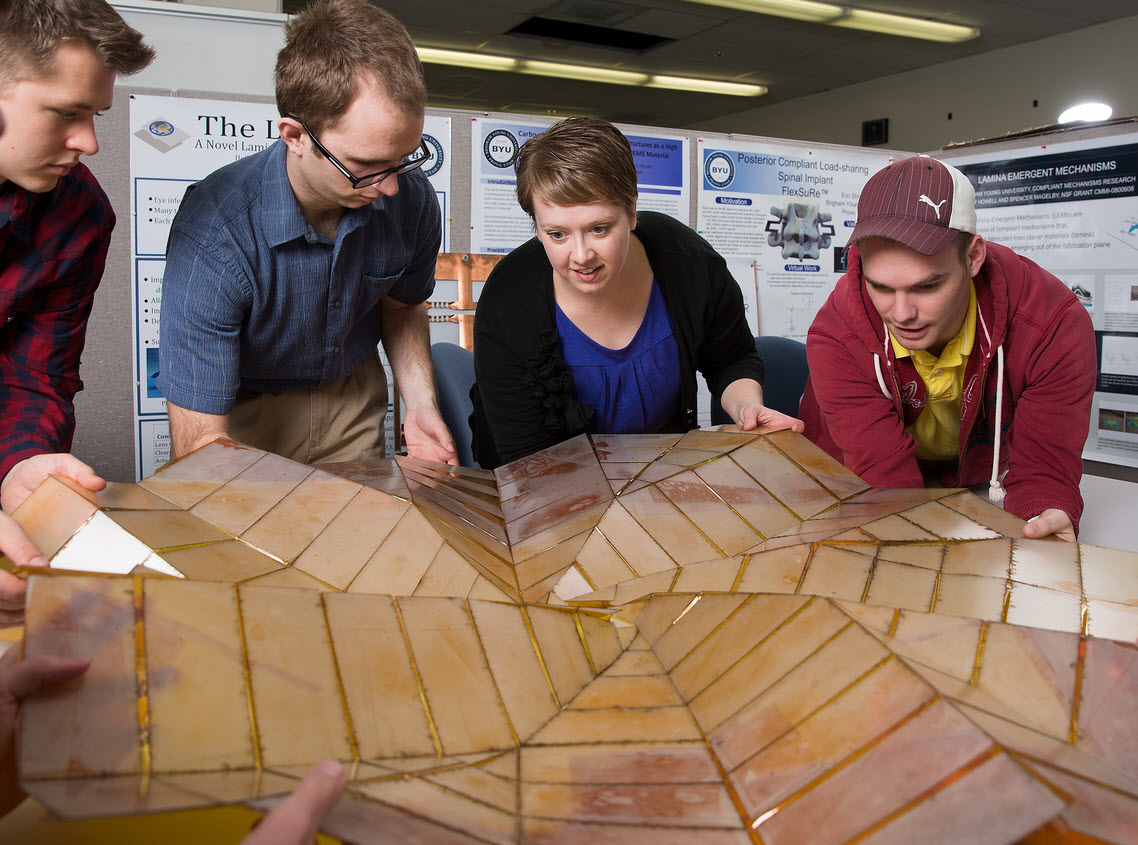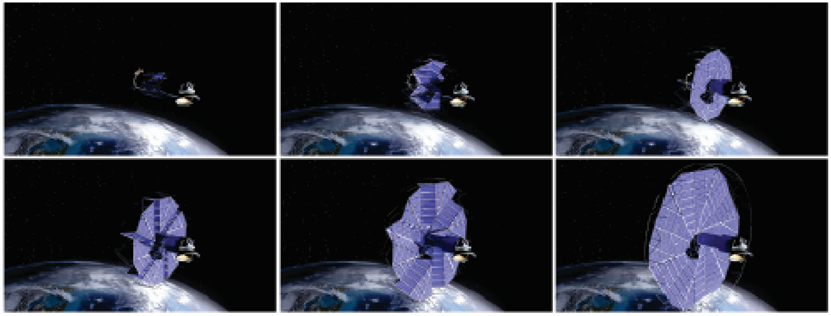Origami solves a space problem
December 3, 2013
[+]
Brigham Young University (BYU)
engineers have teamed up with a world-renowned origami expert to solve
one of space exploration’s greatest (and most ironic) problems: lack of
space.
Mechanical
engineering PhD student Shannon Zirbel and a team of students work on a
solar array prototype that uses Origami (credit: BYU)
Working with NASA’s Jet Propulsion Laboratory, a team of mechanical engineering students and faculty have designed a solar array that can be tightly compacted for launch and then deployed in space to generate power for space stations or satellites.
Applying origami principles on rigid silicon solar panels — a material considerably thicker than the paper used for the traditional Japanese art — the BYU-conceived solar array would unfold to nearly 10 times its stored size.
“It’s expensive and difficult to get things into space; you’re very constrained in space,” said BYU professor and research team leader Larry Howell. “With origami you can make it compact for launch and then as you get into space it can deploy and be large.”
Maximum packing density
The current project, detailed in the November issue of the Journal of Mechanical Design, is propelled by collaboration between BYU, NASA and origami expert Robert Lang. Howell reached out to Lang as part of landing a $2 million National Science Foundation grant in 2012 to explore the combination of origami and compliant mechanisms (joint-less, elastic structures that use flexibility to create movement).
BYU was already working with NASA through the Jet Propulsion Lab, where grad student Shannon Zirbel has been instrumental in the project.
[+]
The particular solar array developed by the group can be folded
tightly down to a diameter of 2.7 meters and unfolded to its full size
of 25 meters across. The goal is to create an array that can produce 250
kilowatts of power. Currently, the International Space Station has
eight solar arrays that generate 84 kilowatts of energy.
A
computer-generated model of the solar array as it might work on a
spacecraft. The solar array is compact for launch, then deploys when in
space. (Credit: Journal of Mechanical Design)
[+]
Howell said origami through compliant mechanisms is a perfect fit for
space exploration: It is low cost and the materials can handle harsh
solar environments. “Space is a great place for a solar panel because
you don’t have to worry about nighttime and there are no clouds and no
weather,” he said. “Origami could also be used for antennas, solar sails
and even expandable nets used to catch asteroids.”
A
rigid-foldable six-sided origami model. The thickness of the panels
governs the final size of the stowed model. (a) Deployed configuration;
the orange path marks the number of panels on each side of the stowed
model. (b) The rigid panels are taped on the side corresponding to the
direction of the fold (mountain or valley). (c) Stowed configuration.
(Credit: Journal of Mechanical Design)
Earth applications
“This technology can also be valuable in applications ranging from minimally invasive surgery (surgical devices like stents that are small during incision and expand to do complex tasks at the surgery site) to consumer products (lower shipping costs or smaller storage space),” Howell explained to KurzweilAI. “We have also explored cube sat versions, which may be possible power sources for small satellites or for earth-based applications, particularly backpackable solar panels.
Other applications Howell said may be possible include phones that can be compact when you’re not using them and then unfold for use and deployable housing or shelters that can be shipped or parachuted compactly* and then expanded for emergency use.
“If we can extend the knowledge of origami artists to work in materials beyond paper, it will lead to powerful systems with unprecedented performance. We will do things no one has ever done before.”
(¯`*• Global Source and/or more resources at http://goo.gl/zvSV7 │ www.Future-Observatory.blogspot.com and on LinkeIn Group's "Becoming Aware of the Futures" at http://goo.gl/8qKBbK │ @SciCzar │ Point of Contact: www.linkedin.com/in/AndresAgostini
 Washington
Washington